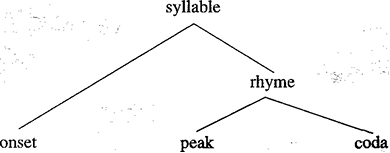


 Grammar
Grammar
 Tenses
Tenses
 Present
Present
 Past
Past
 Future
Future
 Parts Of Speech
Parts Of Speech
 Nouns
Nouns
 Verbs
Verbs
 Adverbs
Adverbs
 Adjectives
Adjectives
 Pronouns
Pronouns
 Pre Position
Pre Position
 Preposition by function
Preposition by function 
 Preposition by construction
Preposition by construction
 Conjunctions
Conjunctions
 Interjections
Interjections
 Grammar Rules
Grammar Rules
 Linguistics
Linguistics
 Semantics
Semantics
 Pragmatics
Pragmatics
 Reading Comprehension
Reading Comprehension|
Read More
Date: 2024-10-14
Date: 2024-10-17
Date: 2024-10-11
|
1. Some people pronounce the word 'syringe' as srɪnʤ; there are no other cases of sr unless one counts foreign names (e.g. Sri Lanka).
2. Many Welsh names (including some well known outside Wales) - such as girls' names like Gwen and place names like the county of Gwent - have initial gw and English speakers seem to find them perfectly easy to pronounce.
3. Two cases make ʃw seem familiar: the vowel name 'schwa', and the name of the soft drinks brand Schweppes. This is, however, a very infrequent cluster for English.
4. The only possible occurrence of gj would be in the archaic (heraldic) word 'gules', which is in very few people's vocabulary.
5. θj occurs in the archaic word 'thew' only.
We now have a similar task to do in studying final consonant clusters. Here we find the possibility of up to four consonants at the end of a word. If there is no final consonant we say that there is a zero coda. When there is one consonant only, this is called the final consonant. Any consonant may be a final consonant except h, w, j. The consonant r is a special case: it doesn't occur as a final consonant in BBC pronunciation, but there are many rhotic accents of English in which syllables may end with this consonant. There are two sorts of two consonant final cluster, one being a final consonant preceded by a pre-final consonant and the other a final consonant followed by a post-final consonant. The pre-final consonants form a small set: m, n, ŋ, l, s. We can see these in 'bump' bΛmp, 'bent' bent, 'bank' bæŋk, 'belt' belt, 'ask' a:sk. The post-final consonants also form a small set: s, z, t, d, θ; example words are: 'bets' bets, 'beds' bedz, 'backed' baekt, 'bagged' bægd, 'eighth' eɪtθ. These post-final consonants can often be identified as separate morphemes (although not always - 'axe' æks, for example, is a single morpheme and its final s has no separate meaning). A point of pronunciation can be pointed out here: the release of the first plosive of a plosive-plus-plosive cluster such as the g (of gd) in b{gd or the k (of kt) in bækt is usually without plosion and is therefore practically inaudible.
There are two types of final three-consonant cluster; the first is pre-final plus final plus post-final, as set out in the following table:

The second type shows how more than one post-final consonant can occur in a final cluster: final plus post-final l plus post-final 2. Post-final 2 is again one of s, z, t, d, θ.

Most four-consonant clusters can be analyzed as consisting of a final consonant preceded by a pre-final and followed by post-final 1 and post-final 2, as shown below:

A small number of cases seem to require a different analysis, as consisting of a final consonant with no pre-final but three post-final consonants:

To sum up, we may describe the English syllable as having the following maximum phonological structure:

In the above structure there must be a vowel in the centre of the syllable. There is, however, a special case, that of syllabic consonants; we do not, for example, analyze the word 'students' stju:dnts as consisting of one syllable with the three-consonant cluster stj for its onset and a four-consonant final cluster dnts. To fit in with what English speakers feel, we say that the word contains two syllables, with the second syllable ending with the cluster nts; in other words, we treat the word as though there was a vowel between d and n, although a vowel only occurs here in very slow, careful pronunciation. This phonological problem will be discussed later.
Much present-day work in phonology makes use of a rather more refined analysis of the syllable in which the vowel and the coda (if there is one) are known as the rhyme; if you think of rhyming English verse you will see that the rhyming works by matching just that part of the last syllable of a line. The rhyme is divided into the peak (normally the vowel) and the coda (but note that this is optional: the rhyme may have no coda, as in a word like 'me'). As we have seen, the syllable may also have an onset, but this is not obligatory. The structure is thus the following:

|
|
|
|
علامات بسيطة في جسدك قد تنذر بمرض "قاتل"
|
|
|
|
|
|
|
أول صور ثلاثية الأبعاد للغدة الزعترية البشرية
|
|
|
|
|
|
|
جامعة كربلاء: مشاريع العتبة العباسية الزراعية أصبحت مشاريع يحتذى بها
|
|
|